Double-Peaked Mid-Infrared Generation Based on Intracavity Difference Frequency Generation
Abstract
1. Introduction
2. Experimental Setup and Methods
3. Results and Discussion
4. Conclusions
Author Contributions
Funding
Data Availability Statement
Acknowledgments
Conflicts of Interest
References
- Li, G.; Zhang, Z.; Zhang, X.; Wu, Y.; Ma, K.; Jiao, Y.; Zhao, H.; Song, Y.; Liu, Y.; Zhai, S. Performance of a Mid-Infrared Sensor for Simultaneous Trace Detection of Atmospheric CO and N2O Based on PSO-KELM. Front. Chem. 2022, 10, 930766. [Google Scholar] [CrossRef] [PubMed]
- Wei, S.; Kulkarni, P.; Zheng, L.; Ashley, K. Aerosol Analysis Using Quantum Cascade Laser Infrared Spectroscopy: Application to Crystalline Silica Measurement. J. Aerosol Sci. 2020, 150, 105643. [Google Scholar] [CrossRef]
- Akhgar, C.K.; Ebner, J.; Alcaraz, M.R.; Kopp, J.; Goicoechea, H.; Spadiut, O.; Schwaighofer, A.; Lendl, B. Application of Quantum Cascade Laser-Infrared Spectroscopy and Chemometrics for In-Line Discrimination of Coeluting Proteins from Preparative Size Exclusion Chromatography. Anal. Chem. 2022, 94, 11192–11200. [Google Scholar] [CrossRef]
- Lamard, L.; Balslev-Harder, D.; Peremans, A.; Petersen, J.C.; Lassen, M. Versatile Photoacoustic Spectrometer Based on a Mid-Infrared Pulsed Optical Parametric Oscillator. Appl. Opt. 2019, 58, 250. [Google Scholar] [CrossRef] [PubMed]
- Fjodorow, P.; Frolov, M.P.; Korostelin, Y.V.; Kozlovsky, V.I.; Schulz, C.; Leonov, S.O.; Skasyrsky, Y.K. Room-Temperature Fe:ZnSe Laser Tunable in the Spectral Range of 3.7–5.3 μm Applied for Intracavity Absorption Spectroscopy of CO2 Isotopes, CO and N2O. Opt. Express 2021, 29, 12033. [Google Scholar] [CrossRef] [PubMed]
- Luo, J.; Li, B.; Zhou, X.; Qin, Z.; Xie, G. Laser Deicing for High-Voltage Composite Insulator by High-Power Mid-Infrared Fiber Laser. Opt. Eng. 2021, 61, 021005. [Google Scholar] [CrossRef]
- Meng, D.; Zhang, H.; Li, M.; Lin, W.; Shen, Z.; Zhang, J.; Fan, Z. Laser Technology for Direct IR Countermeasure System. Infrared Laser Eng. 2018, 47, 1105009. [Google Scholar] [CrossRef]
- Wang, Z.; Zhang, B.; Liu, J.; Song, Y.; Zhang, H. Recent Developments in Mid-Infrared Fiber Lasers: Status and Challenges. Opt. Laser Technol. 2020, 132, 106497. [Google Scholar] [CrossRef]
- Xu, M.; Yu, F.; Hassan, M.R.A.; Knight, J.C. Continuous-Wave Mid-Infrared Gas Fiber Lasers. IEEE J. Select. Topics Quantum Electron. 2018, 24, 0902308. [Google Scholar] [CrossRef]
- Täschler, P.; Bertrand, M.; Schneider, B.; Singleton, M.; Jouy, P.; Kapsalidis, F.; Beck, M.; Faist, J. Femtosecond Pulses from a Mid-Infrared Quantum Cascade Laser. Nat. Photon. 2021, 15, 919–924. [Google Scholar] [CrossRef]
- Gu, C.; Zuo, Z.; Luo, D.; Peng, D.; Di, Y.; Zou, X.; Yang, L.; Li, W. High-Repetition-Rate Femtosecond Mid-Infrared Pulses Generated by Nonlinear Optical Modulation of Continuous-Wave QCLs and ICLs. Opt. Lett. 2019, 44, 5848. [Google Scholar] [CrossRef] [PubMed]
- Zhang, X.; Hu, H.; Li, W.; Dutta, N.K. Mid-Infrared Supercontinuum Generation in Tapered As2S3 Chalcogenide Planar Waveguide. J. Mod. Opt. 2016, 63, 1965–1971. [Google Scholar] [CrossRef]
- O’Donnell, C.F.; Kumar, S.C.; Paoletta, T.; Ebrahim-Zadeh, M. Widely Tunable Femtosecond Soliton Generation in a Fiber-Feedback Optical Parametric Oscillator. Optica 2020, 7, 426. [Google Scholar] [CrossRef]
- Yang, K.; Li, J.; Gao, Y.; Wei, D.; Yao, B.; Wang, J.; Cheng, H.; Tang, J.; Mi, S.; Duan, X.; et al. Watt-Level Long-Wave Infrared CdSe Pulsed-Nanosecond Optical Parametric Oscillator. Opt. Laser Technol. 2022, 145, 107491. [Google Scholar] [CrossRef]
- He, Y.; Ji, Y.; Wan, H.; Yu, D.; Zhang, K.; Pan, Q.; Sun, J.; Chen, Y.; Chen, F. High-Power Mid-Infrared Pulse MgO:PPLN Optical Parametric Oscillator Pumped by Linearly Polarized Yb-Doped All-Fiber Laser. Opt. Laser Technol. 2022, 146, 107545. [Google Scholar] [CrossRef]
- Ulvila, V.; Vainio, M. Diode-Laser-Pumped Continuous-Wave Optical Parametric Oscillator with a Large Mid-Infrared Tuning Range. Opt. Commun. 2019, 439, 99–102. [Google Scholar] [CrossRef]
- Liu, Y.; Xie, X.; Ning, J.; Lv, X.; Zhao, G.; Xie, Z.; Zhu, S. A High-Power Continuous-Wave Mid-Infrared Optical Parametric Oscillator Module. Appl. Sci. 2017, 8, 1. [Google Scholar] [CrossRef]
- Cheng, X.; Dong, J.; Zeng, X.; Zhou, J.; Cui, S.; Qi, W.; Lin, Z.; Jiang, H.; Feng, Y. 130 W Continuous-Wave Supercontinuum Generation within a Random Raman Fiber Laser. Opt. Fiber Technol. 2022, 68, 102825. [Google Scholar] [CrossRef]
- Ren, T.; Wu, C.; Yu, Y.; Dai, T.; Chen, F.; Pan, Q. Development Progress of 3–5 µm Mid-Infrared Lasers: OPO, Solid-State and Fiber Laser. Appl. Sci. 2021, 11, 11451. [Google Scholar] [CrossRef]
- Jindal, M.K.; Veerabuthiran, S.; Mainuddin; Razdan, A.K. Integrated Path DIAL for Standoff Detection of Acetone Vapors under Topographic Target Condition. Opt. Laser Technol. 2021, 143, 107299. [Google Scholar] [CrossRef]
- Veerabuthiran, S.; Razdan, A.K.; Jindal, M.K.; Prasad, G. Open Field Testing of Mid IR DIAL for Remote Detection of Thiodiglycol Vapor Plumes in the Topographic Target Configuration. Sens. Actuators B Chem. 2019, 298, 126833. [Google Scholar] [CrossRef]
- Romanovskii, O.A.; Sadovnikov, S.A.; Kharchenko, O.V.; Yakovlev, S.V. Development of Near/Mid IR Differential Absorption OPO Lidar System for Sensing of Atmospheric Gases. Opt. Laser Technol. 2019, 116, 43–47. [Google Scholar] [CrossRef]
- Gong, Y.; Bu, L.; Yang, B.; Mustafa, F. High Repetition Rate Mid-Infrared Differential Absorption Lidar for Atmospheric Pollution Detection. Sensors 2020, 20, 2211. [Google Scholar] [CrossRef]
- Van Nguyen, D.; Cadatal-Raduban, M.; Van Pham, D.; Nguyen, T.X.; Van Vu, T.; Pham, M.H. Tunable Dual Wavelength and Narrow Linewidth Laser Using a Single Solid-State Gain Medium in a Double Littman Resonator. Opt. Commun. 2021, 496, 127131. [Google Scholar] [CrossRef]
- Mariani, Z.; Stanton, N.; Whiteway, J.; Lehtinen, R. Toronto Water Vapor Lidar Inter-Comparison Campaign. Remote Sens. 2020, 12, 3165. [Google Scholar] [CrossRef]
- Pencheva, V.; Penchev, S.; Dreischuh, T. Development of Lidar for Remote Methane Sensing Using an Optimal Configuration of High-Power Laser Diodes. J. Phys. Conf. Ser. 2022, 2240, 012033. [Google Scholar] [CrossRef]
- Yang, Z.; Zhang, Y.; Chen, Y.; Li, X.; Jiang, Y.; Feng, Z.; Deng, B.; Chen, C.; Zhou, D. Simultaneous Detection of Multiple Gaseous Pollutants Using Multi-Wavelength Differential Absorption LIDAR. Opt. Commun. 2022, 518, 128359. [Google Scholar] [CrossRef]
- Veerabuthiran, S.; Razdan, A.K.; Jindal, M.K.; Sharma, R.K.; Sagar, V. Development of 3.0–3.45µm OPO Laser Based Range Resolved and Hard-Target Differential Absorption Lidar for Sensing of Atmospheric Methane. Opt. Laser Technol. 2015, 73, 1–5. [Google Scholar] [CrossRef]
- Romanovskii, O.A.; Sadovnikov, S.A.; Kharchenko, O.V.; Yakovlev, S.V. Remote Analysis of Methane Concentration in the Atmosphere with an IR Lidar System in the 3300–3430 μm Spectral Range. Atmos. Ocean Opt. 2020, 33, 188–194. [Google Scholar] [CrossRef]
- Romanovskii, O.A.; Sadovnikov, S.A.; Kharchenko, O.V.; Shumsky, V.K.; Yakovlev, S.V. Optical Parametric Oscillators in Lidar Sounding of Trace Atmospheric Gases in the 3–4 μm Spectral Range. Opt. Mem. Neural Netw. 2016, 25, 88–94. [Google Scholar] [CrossRef]
- Zhang, X.; Guo, T.; Kang, P.; Huang, J. Compact Dual-Crystal Tm, Ho:YLF Laser with Balanced Orthogonal Polarization Output Power. Opt. Express 2021, 29, 25762. [Google Scholar] [CrossRef] [PubMed]
- Feng, X.; Shi, J.; Liu, P.; Zhang, Z. Broadband Mid-Infrared Coherent Light Source from Fiber-Laser-Pumped Difference Frequency Generators Based on Cascaded Crystals. Opt. Express 2020, 28, 14310. [Google Scholar] [CrossRef] [PubMed]
- Fu, Q.; Xu, L.; Liang, S.; Shardlow, P.C.; Shepherd, D.P.; Alam, S.; Richardson, D.J. High-Average-Power Picosecond Mid-Infrared OP-GaAs OPO. Opt. Express 2020, 28, 5741. [Google Scholar] [CrossRef] [PubMed]
- Bauer, C.P.; Camenzind, S.L.; Pupeikis, J.; Willenberg, B.; Phillips, C.R.; Keller, U. Dual-Comb Optical Parametric Oscillator in the Mid-Infrared Based on a Single Free-Running Cavity. Opt. Express 2022, 30, 19904. [Google Scholar] [CrossRef]
- Boutabba, N.; Grira, S.; Eleuch, H. Analysis of a Q-Deformed Hyperbolic Short Laser Pulse in a Multi-Level Atomic System. Sci. Rep. 2022, 12, 9308. [Google Scholar] [CrossRef] [PubMed]
- Boutabba, N.; Grira, S.; Eleuch, H. Atomic Population Inversion and Absorption Dispersion-Spectra Driven by Modified Double-Exponential Quotient Pulses in a Three-Level Atom. Results Phys. 2021, 24, 104108. [Google Scholar] [CrossRef]
- Gasmi Cherifi, T. New All-Solid-State KTA-Based DIAL for Tropospheric Methane Monitoring. EPJ Web Conf. 2020, 237, 03017. [Google Scholar] [CrossRef]
- Romanovskii, O.A.; Sadovnikov, S.A.; Kharchenko, O.V.; Yakovlev, S.V. Opo Lidar Sounding of Trace Atmospheric Gases in the 3–4 Μm Spectral Range. EPJ Web Conf. 2018, 176, 05016. [Google Scholar] [CrossRef]
- Ning, C.; Feng, X.; Heng, J.; Zhang, Z. Supercontinuum Generation from a Quasi-Stationary Doubly Resonant Optical Parametric Oscillator. Opt. Lett. 2021, 46, 4280. [Google Scholar] [CrossRef]
- Tian, X.; Zhao, X.; Wang, M.; Wang, Z. Suppression of Stimulated Brillouin Scattering in Optical Fibers by Tilted Fiber Bragg Gratings. Opt. Lett. 2020, 45, 4802. [Google Scholar] [CrossRef]
- Feng, J.; Cheng, X.; Li, X.; Wang, P.; Hua, W.; Han, K. Highly Efficient Mid-Infrared Generation from Low-Power Single-Frequency Fiber Laser Using Phase-Matched Intracavity Difference Frequency Mixing. Appl. Sci. 2020, 10, 7454. [Google Scholar] [CrossRef]
- Cheng, X.; Wang, P.; Li, X.; Zhou, P.; Xiao, H.; Liu, Z.; Han, K. Low Threshold, Dual-Wavelength, Mid-Infrared Optical Parametric Oscillator. IEEE Photonics J. 2019, 11, 7100307. [Google Scholar] [CrossRef]
- Yanagawa, T.; Kanbara, H.; Tadanaga, O.; Asobe, M.; Suzuki, H.; Yumoto, J. Broadband Difference Frequency Generation around Phase-Match Singularity. Appl. Phys. Lett. 2005, 86, 161106. [Google Scholar] [CrossRef]
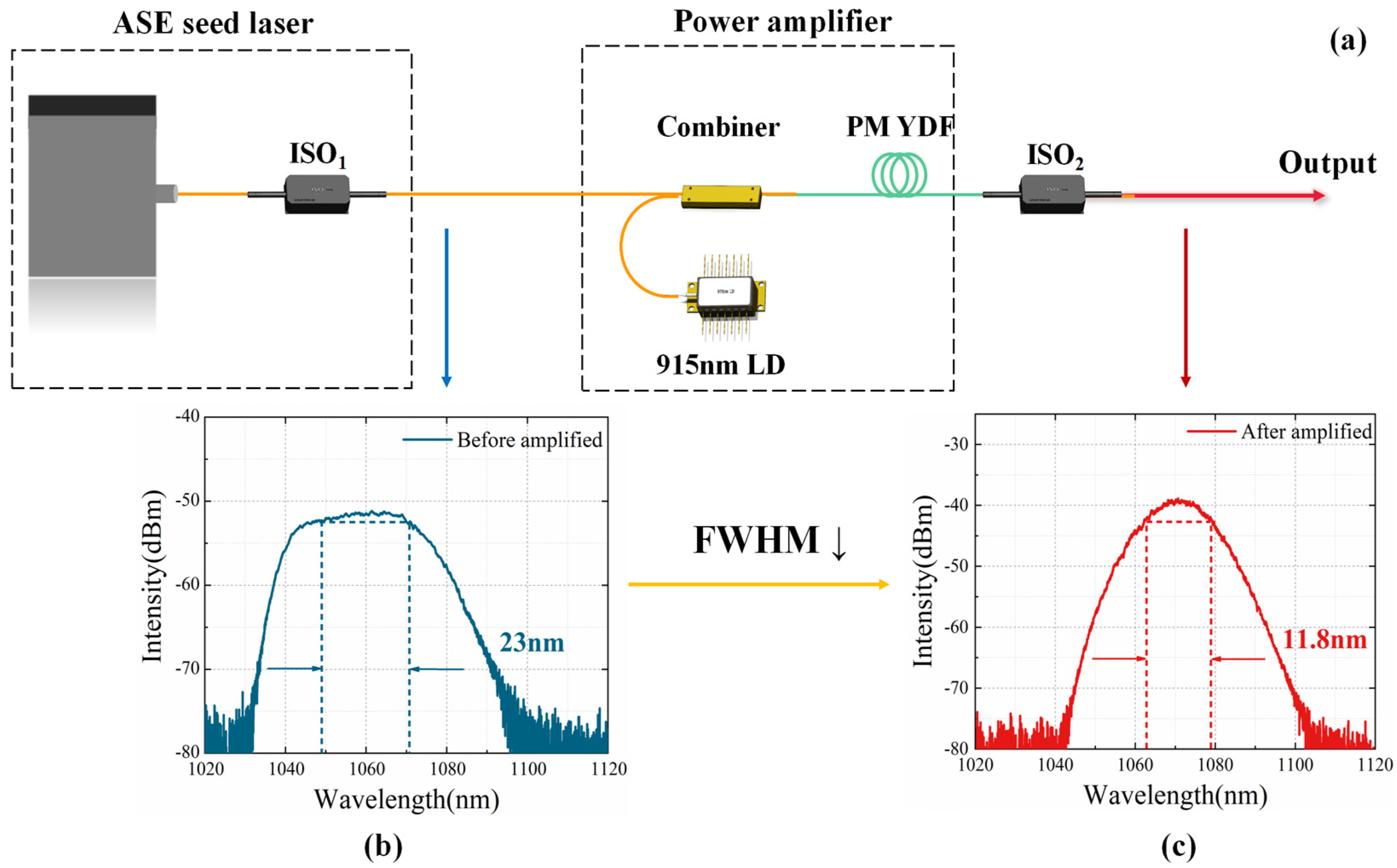
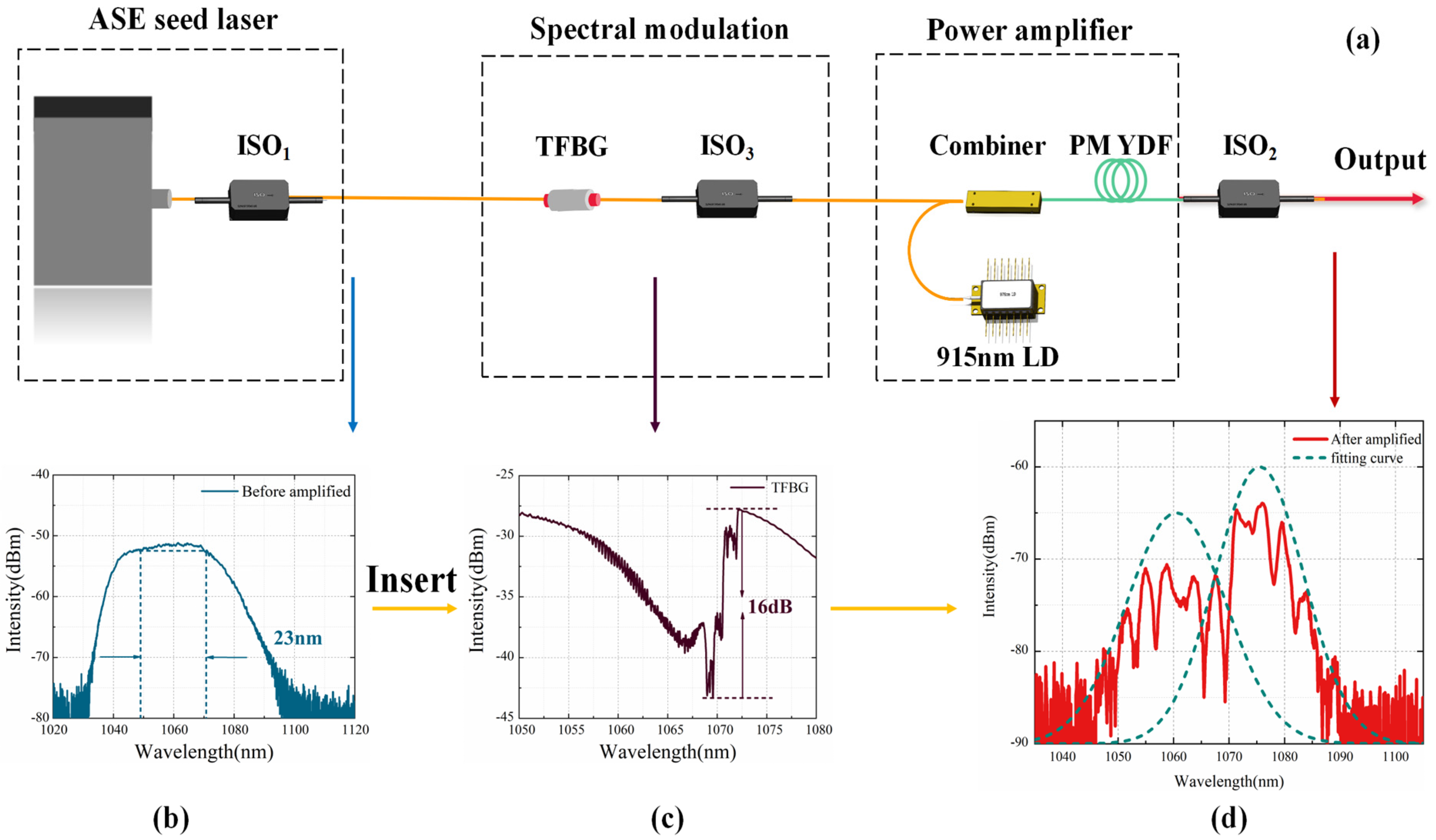
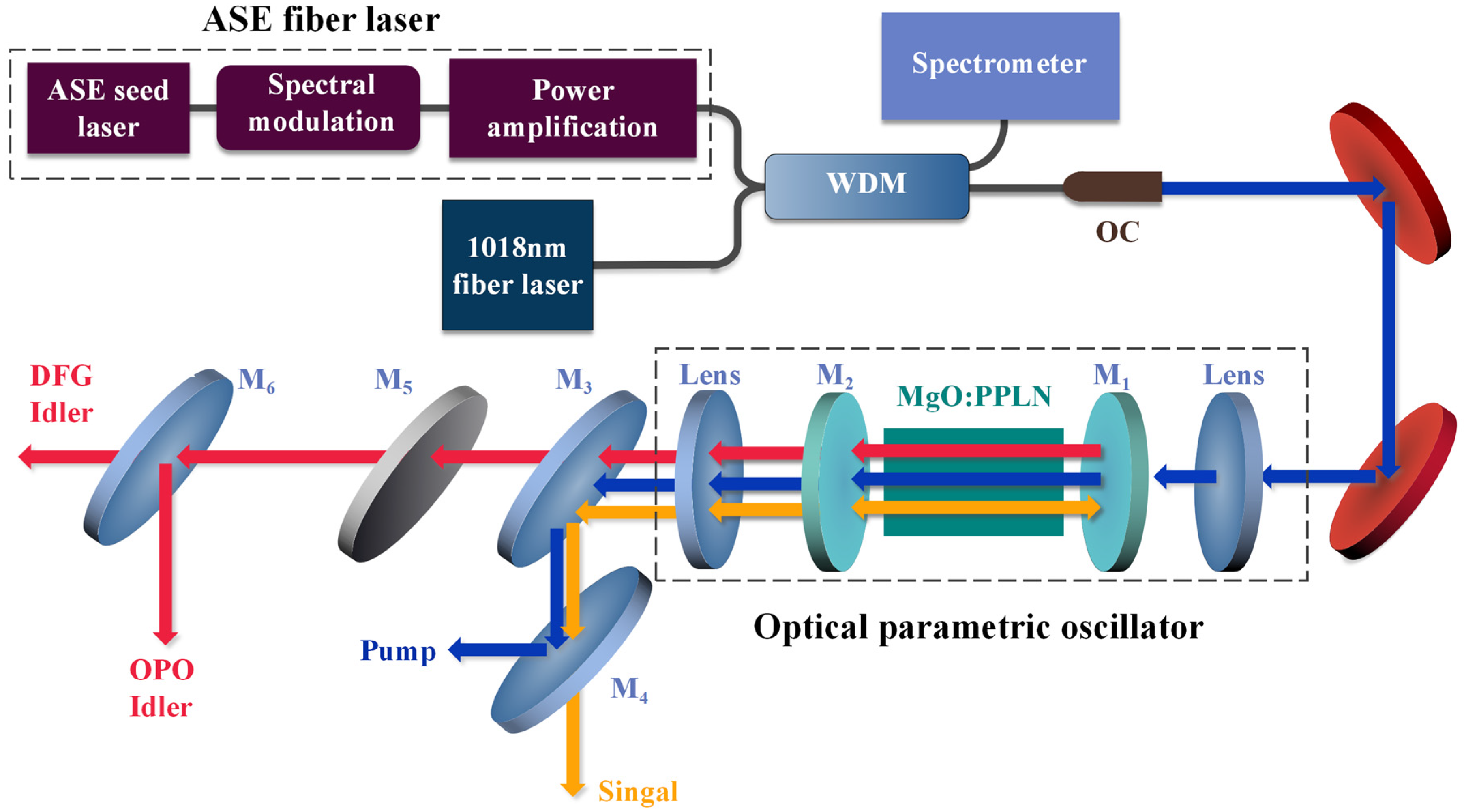
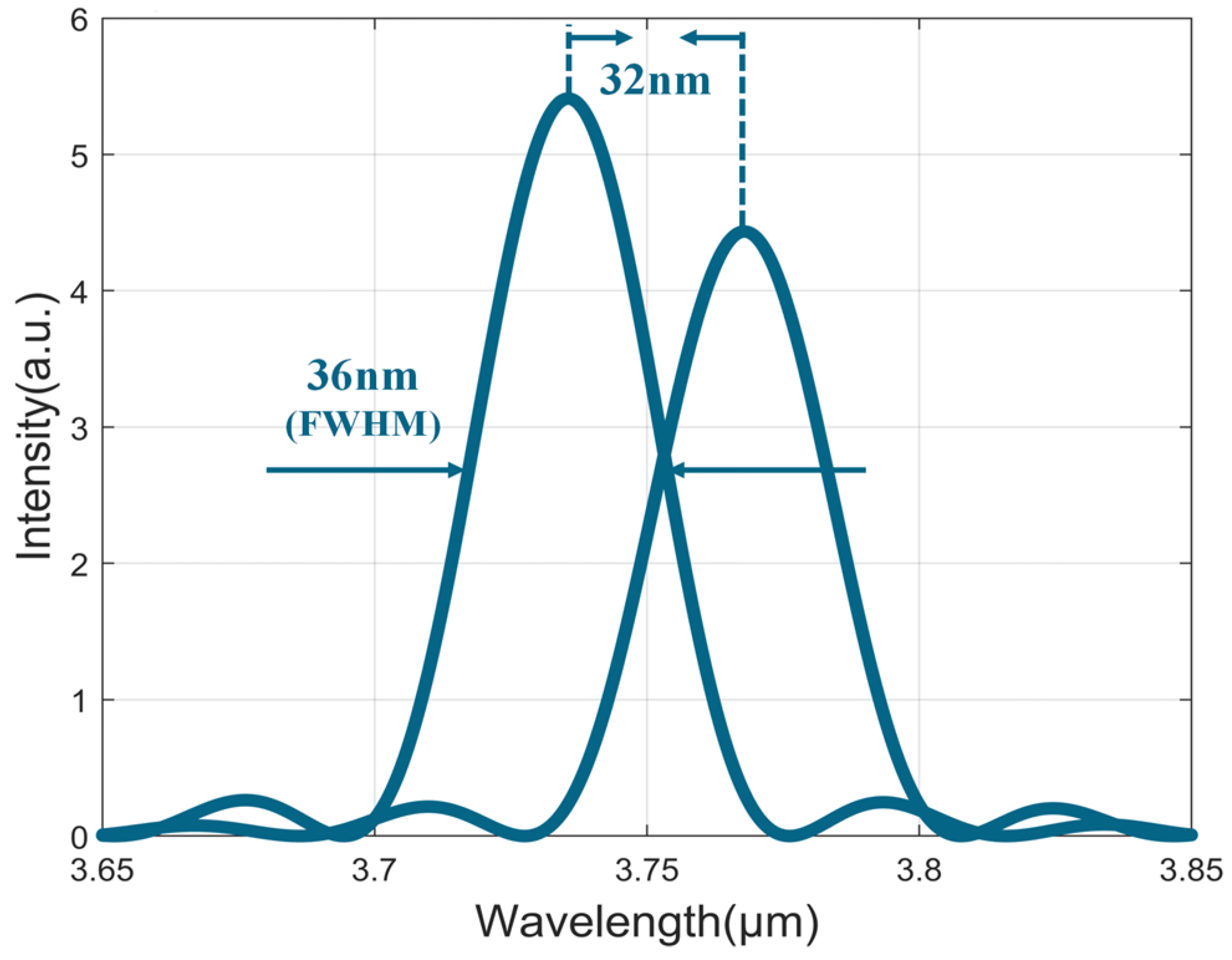
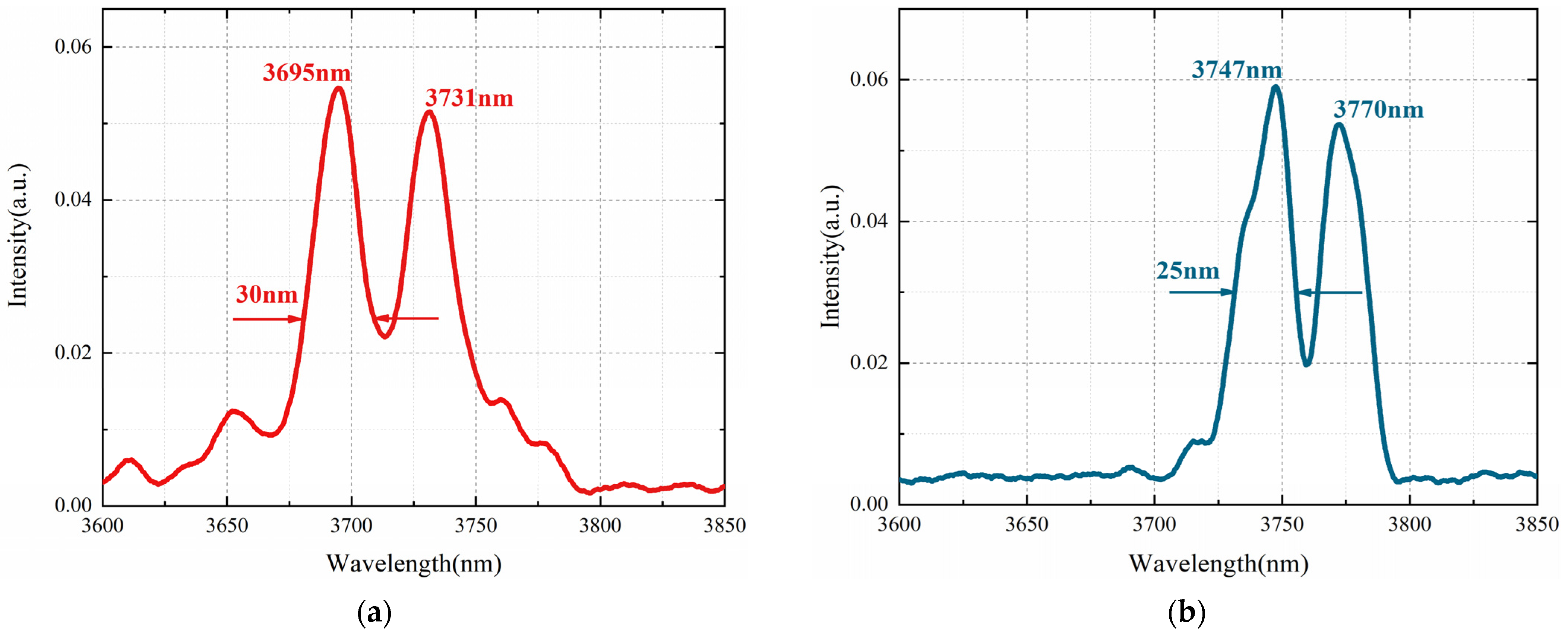
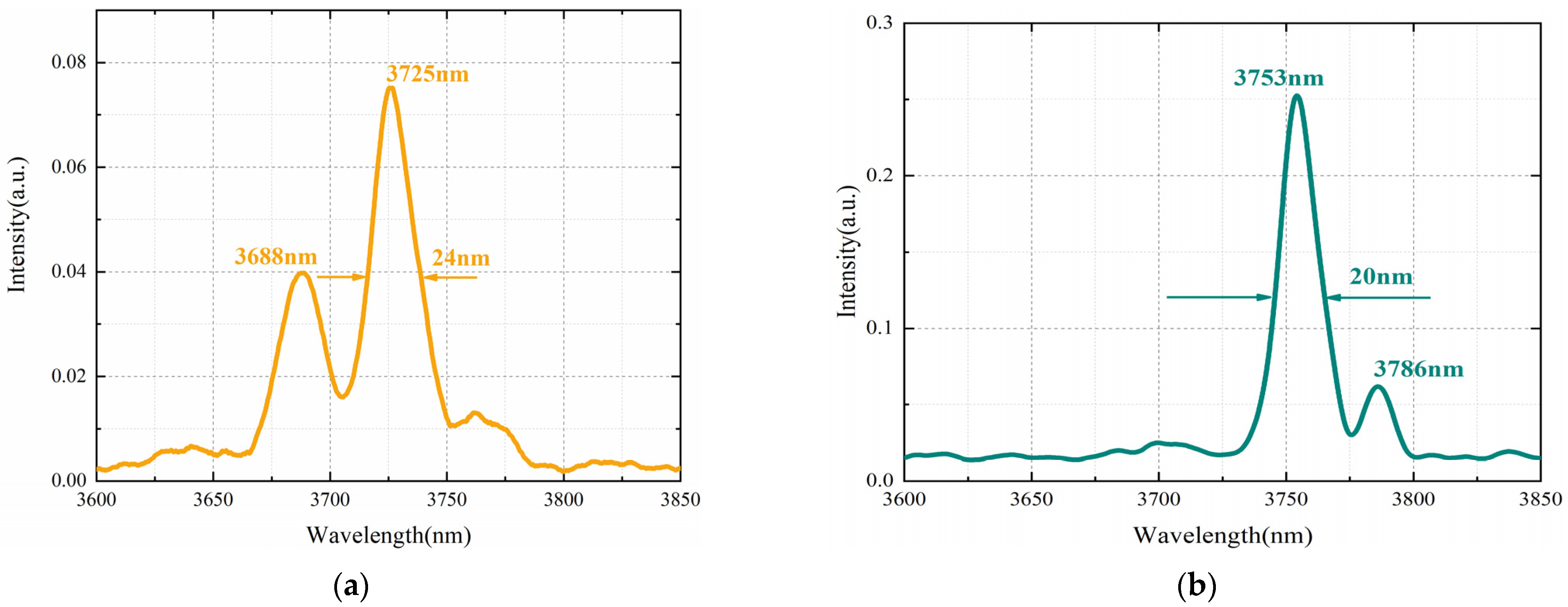
Publisher’s Note: MDPI stays neutral with regard to jurisdictional claims in published maps and institutional affiliations. |
© 2022 by the authors. Licensee MDPI, Basel, Switzerland. This article is an open access article distributed under the terms and conditions of the Creative Commons Attribution (CC BY) license (https://creativecommons.org/licenses/by/4.0/).
Share and Cite
Wang, K.; Li, X.; Wang, P.; Wang, M.; Hua, W.; Han, K.; Wang, Z. Double-Peaked Mid-Infrared Generation Based on Intracavity Difference Frequency Generation. Appl. Sci. 2022, 12, 11644. https://doi.org/10.3390/app122211644
Wang K, Li X, Wang P, Wang M, Hua W, Han K, Wang Z. Double-Peaked Mid-Infrared Generation Based on Intracavity Difference Frequency Generation. Applied Sciences. 2022; 12(22):11644. https://doi.org/10.3390/app122211644
Chicago/Turabian StyleWang, Kaifeng, Xiao Li, Peng Wang, Meng Wang, Weihong Hua, Kai Han, and Zefeng Wang. 2022. "Double-Peaked Mid-Infrared Generation Based on Intracavity Difference Frequency Generation" Applied Sciences 12, no. 22: 11644. https://doi.org/10.3390/app122211644
APA StyleWang, K., Li, X., Wang, P., Wang, M., Hua, W., Han, K., & Wang, Z. (2022). Double-Peaked Mid-Infrared Generation Based on Intracavity Difference Frequency Generation. Applied Sciences, 12(22), 11644. https://doi.org/10.3390/app122211644





